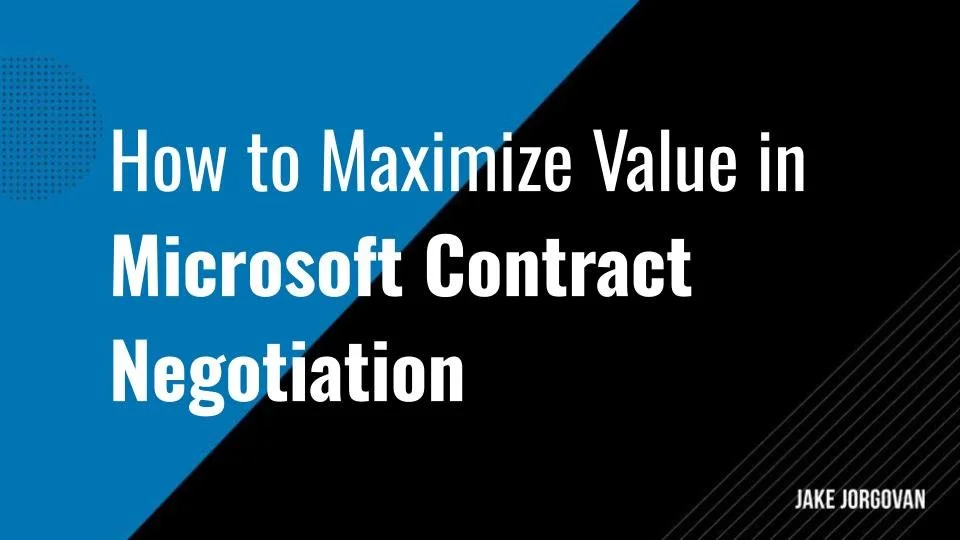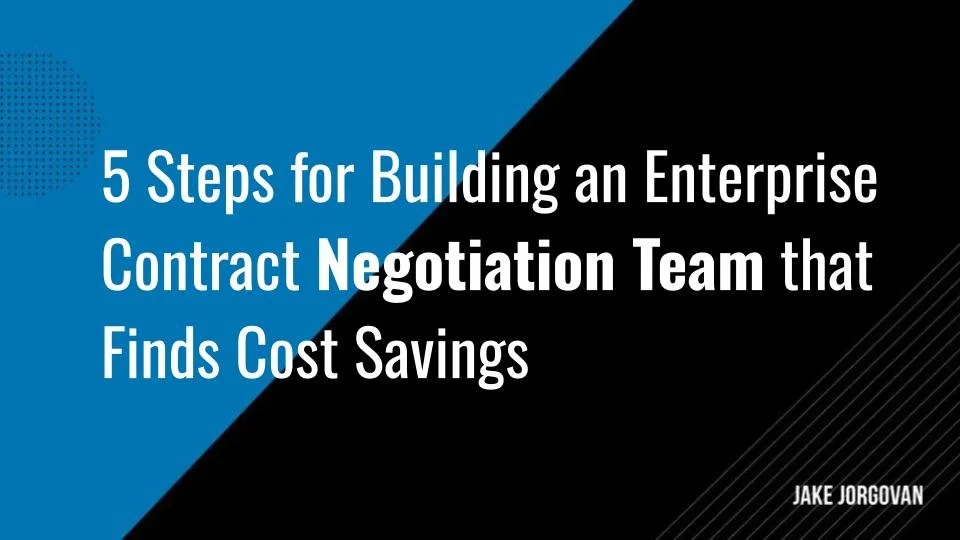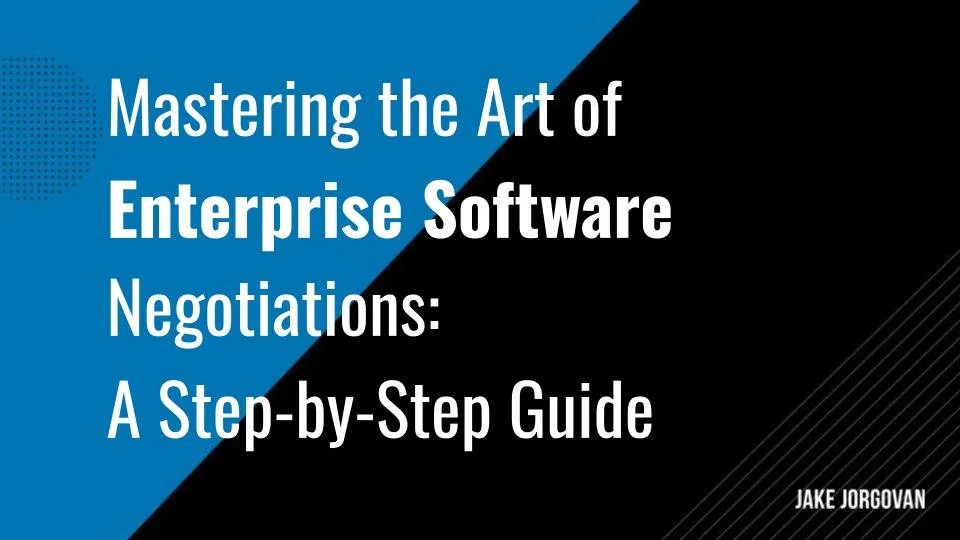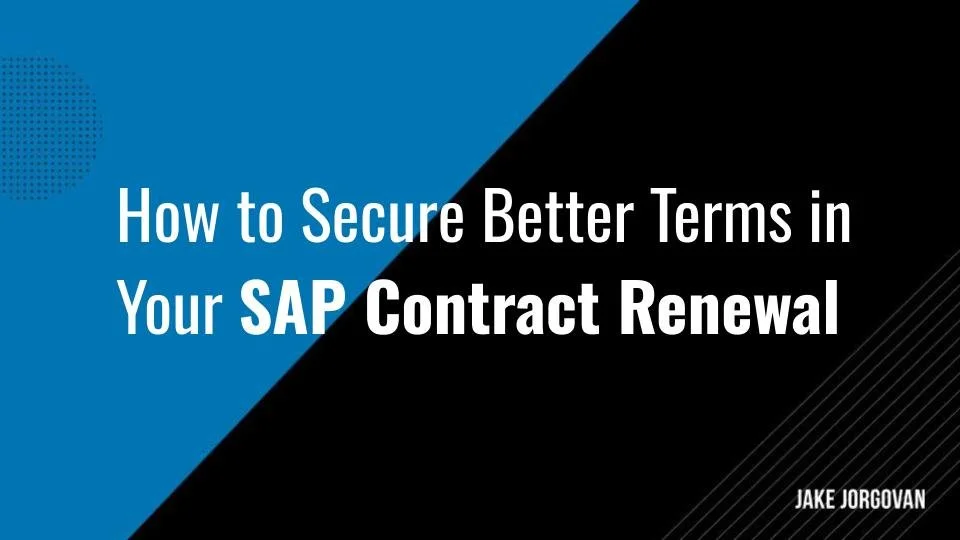How to Negotiate Enterprise Software Contracts for Cost Savings: A Step-By-Step Guide
Negotiating enterprise software contracts is critical for any business looking to optimize costs.
These legal agreements are complex and can significantly impact your organization's budget. Understanding how to navigate these negotiations effectively can lead to substantial savings.
This guide provides a step-by-step approach to securing the best possible terms.
Whether you're a seasoned negotiator or new to software procurement, you'll find actionable strategies that are directly applicable. Considering that enterprise software spending reached approximately $913 billion globally in 2023, equipping yourself with effective negotiation skills is essential to manage and reduce these substantial expenditures.
The Importance of Finding Savings in Enterprise Software Contracts
Finding cost savings during the software contract negotiation process is about optimizing your investment to fuel growth and innovation within your company. Focusing on procurement cost savings is a top priority for many companies, with 43% of purchasing departments identifying cost reduction as their primary strategic goal.
There are lots of strategies you can use, like those shown in the graphic below and the rest of the article.
Here's why sharpening your focus on cost efficiency matters:
Direct impact on profitability: Every dollar saved on software procurement directly boosts your bottom line. Lowering these costs can free up resources for other strategic investments that drive competitive advantage.
Enables greater investment flexibility: Cost savings create more room in your budget. This flexibility can be crucial for funding other areas like R&D, marketing, or expanding your operational capacities.
Encourages vendor competition: When you emphasize cost savings, vendors are compelled to offer their best software prices to secure your business. This results in better upfront terms and can lead to more favorable support and maintenance conditions.
Enhances negotiation leverage: Demonstrating knowledge of cost optimization techniques and market pricing dynamics positions you as an informed buyer. This perception increases your leverage in negotiations, potentially leading to more advantageous terms.
Supports long-term scalability: By securing cost-effective software solutions, you ensure that the technological backbone of your business can scale without prohibitive increases in cost. This is vital for maintaining agility as your business grows.
6 Steps to Negotiate Enterprise Software Contracts for Cost Savings
Let’s jump straight into it with the tactics you’re here for:
1) Identify and Prioritize Your Needs and Goals
Understanding your business needs thoroughly is crucial when you're gearing up to negotiate enterprise software contracts and understand cost implications. Your strategy should focus on aligning software capabilities with your organizational objectives.
To identify and prioritize those needs effectively, first outline what you specifically want the enterprise software to achieve. Consider operational efficiency, data management, customer relationship improvements, protection against security breaches, or other specific business processes you wish to improve. The graphic below shows some examples of things to consider when choosing software:
Then, review the existing technology stack and identify gaps where the new software can add value. Note down any redundancies or limitations in current systems that the new solution could resolve.
It’s a good idea to involve key players from relevant departments early in the process. Gather their input to ensure the software meets cross-functional requirements, which could include integration capabilities, scalability, and user-friendliness. This collaborative approach is essential, as research indicates that 83% of digitally maturing companies utilize cross-functional teams to enhance agility and innovation.
Remember that not all software features carry equal weight. Rank each requirement based on its impact on your business goals and operational needs, which will guide you to focus negotiations on critical elements.
It’s also wise to anticipate the direction your industry is heading and how your company might grow or evolve. Make sure the software can scale and adapt to future challenges and opportunities.
Finally, don’t forget to document everything. Keep a detailed record of your needs assessment. This documentation will serve as a reference throughout the negotiation process to keep discussions focused and productive.
2) Research and Compare Software Vendors and their Pricing
Securing the right software for your company demands a comprehensive evaluation of available vendors. Here are some things you should consider when looking for a vendor:
This phase influences your negotiating power and outcome. Here's how to execute it effectively:
Conduct market research: Start by identifying all potential software vendors that offer solutions aligning with your business needs. Use industry reports and software review platforms to create a list of credible providers.
Evaluate software offerings: Scrutinize each vendor's features, scalability, compatibility with existing systems, and customer support services. Focus on how well these align with the priorities you outlined in step one.
Analyze pricing models: Understand each vendor's pricing structure. Look for transparency in pricing and be wary of hidden costs that could emerge in areas like implementation, training, and additional feature access.
Read customer reviews: Dive into reviews from current users to gauge satisfaction and discover common issues. Pay attention to response times, as well as how vendors handle complaints and support requests, as this will be crucial once you enter a contract.
Check financial health: Assess the vendors' financial stability. A stable provider ensures long-term support and updates, which reduces the risk of disruptions to your business operations.
Request demos and trials: Arrange for demonstrations and free trials where possible. These firsthand experiences will provide deeper insights into the software's functionality and user interface.
Insider tip: We suggest simultaneously initiating preliminary talks with multiple vendors. This approach allows you to compare offers directly and creates competitive tension among vendors. Remember, demonstrating to vendors that their competition is just a meeting away can incentivize them to present their best offer upfront, which maximizes your cost savings in the contract negotiation phase.
3) Negotiate Volume Discounts and Flexible Terms
When entering enterprise software negotiations, your leverage hinges on the strength of your bargaining position. Negotiating for volume discounts and flexible terms becomes key in securing cost efficiencies for your business. Here's a structured approach to guide you:
To begin, assess your volume needs: Calculate the number of users or licenses required for your organization. A larger volume can significantly strengthen your bargaining power for discounts.
Then, consider the potential need to scale up or down in the future. Prepare to discuss licensing flexibility that matches your business’s growth or contraction. Gather information on what competitors or similar-sized companies in your industry pay for similar services. Use this data to argue for competitive pricing.
Offering to commit to a longer contract term can be a trade-off for lower annual costs. This strategy often appeals to vendors looking for stable, long-term customer relationships. Many companies end up giving an additional 10–20% discount for multi-year contracts.
The next step is to negotiate the possibility of extended payment terms or a delayed start of payment. These conditions can ease cash flow, especially for large, upfront software investments.
If the vendor offers multiple products that could benefit your business, discuss bundling them. Bundled offers usually come at a reduced rate compared to purchasing each product separately.
4) Seek Bundled Services and Multi-Year Contract Discounts
Leveraging bundled services and securing multi-year contract discounts are strategic approaches that can lead to significant cost savings compared to annual contracts in enterprise software negotiations. This tactic simplifies management and aligns with budgeting cycles and future plans.
As we discussed previously, committing to longer-term agreements can lead to significant cost savings. Data from Vertice suggests that vendors typically increase their discount by 5% for each additional year a user commits to.
Consider these steps:
Identify bundling opportunities: Review the vendor's product suite to identify additional tools that could lead to favorable outcomes. This can include add-ons, enhanced support, or integrated platforms that improve the core software's functionality.
Check out the graphic below for some benefits of bundling your software services:
Evaluate long-term benefits: Weigh the long-term advantages and potential risks of committing to a multi-year contract. The agreed-upon terms should allow for technological updates and adaptability to keep pace with industry changes.
Negotiate discount tiers: Discuss the possibility of increased discounts with longer commitment periods or higher volume purchases. Vendors are sometimes willing to offer better rates for the assurance of a long-term relationship.
Clarify termination clauses: Ensure that any long-term agreement includes reasonable contract renewal and termination clauses. This protects your company from being locked into an unsatisfactory contract without punitive financial repercussions.
Consider future scalability: The contract should accommodate future business growth or contraction without severe penalties. This includes clauses that allow for adjustments in service levels based on your changing needs.
Secure performance guarantees: Include service level agreements (SLAs) that outline performance expectations and repercussions for not meeting those standards. This ensures that the vendor remains committed to delivering quality service over the duration of the contract.
5) Address Scalability and Future Needs in the Agreement
Addressing scalability and future needs within your contract is essential. This foresight ensures that as your business grows, your software grows with it. Given that 72% of IT leaders believe that scalability is essential for achieving business goals, this is a key consideration. To further highlight this point, check out the stat below:
“Businesses that implement scalable digital enterprise solutions can achieve cost reductions of up to 17% across the organization while simultaneously increasing revenue by the same percentage.” - BCG
To secure this flexibility, start by determining the specific parameters under which your software needs may increase, such as user count, data volume, or transaction rate. These metrics guide the scalability terms.
Ensure the contract allows for adjustments in service based on your company's growth or seasonality without punitive additional costs. This flexibility is vital for adapting to market changes and business expansion.
You’ll want to request clauses that entitle your business to periodic software upgrades. This keeps your systems up-to-date and competitive without renegotiating terms or incurring unexpected expenses.
Establish clear benchmarks and triggers for scalability adjustments within the contract. This transparency prevents disputes and ensures both parties understand when terms are subject to change.
Keep in mind — as new technology and features become available, your agreement should allow access to these innovations. This ensures you benefit from the latest advancements without major contract overhauls.
Finally, address the integration of new technologies and standards that might emerge during the contract term. This foresight prevents getting stuck with antiquated software and ensures seamless operation as the technological landscape evolves.
6) Leverage a Proof of Concept or Trial to Negotiate Better Terms
A proof of concept or trial phase can completely change your enterprise software negotiations. As the graphic below shows, it’s the deciding factor for many businesses.
This is a crucial step to ensure that the software meets all functional expectations before committing fully to a long-term relationship. Here’s how to approach this phase:
Request a trial: Initiate discussions with the software provider by requesting a free trial period for the software to evaluate its performance in real-world scenarios. This trial should allow full access to all essential features for your business operations. Research suggests that free trials are considered the most helpful and trustworthy information source for B2B buyers.
Set trial objectives: Clearly define what you aim to achieve during the trial. Outline some key performance indicators and functionality checks that will determine the software's adequacy for your needs.
Involve your team: Make sure the relevant team members who will use the software are involved in the trial. Their feedback is very important in assessing the software’s usability and effectiveness.
Document results: Keep thorough records of the trial’s outcomes. Document bugs, performance issues, and user feedback to discuss with the vendor post-trial.
Negotiate based on findings: Use the insights gained from the trial to negotiate amendments to the contract terms. This might include requests for customization, additional support, or changes to the pricing structure based on the software’s performance.
Establish exit strategies: In case the software does not meet your expectations, negotiate terms that allow for a no-penalty exit post-trial. This safeguards your investment and keeps options open for other solutions.
Optimize your Enterprise Software Contract Negotiations for Cost Savings
Successful negotiation of enterprise software contracts is essential if you want to maximize cost
savings and improve operational efficiency.
This guide has equipped you with targeted strategies to prepare, negotiate, and secure favorable terms. Remember, thorough preparation and understanding of your needs are critical here. Engaging service providers with clarity and confidence will take your negotiation strategy to the next level.
Use trials and data to argue for fair pricing and beneficial terms. Ultimately, every step you take should align with your business's growth and scalability goals. Implement these strategies consistently to turn software procurement into a strategic advantage for your company.
Frequently Asked Questions
How do you negotiate a tech contract?
Start by clearly defining your business needs, researching market rates, and understanding the vendor’s pricing model. Use this information to negotiate terms such as scalability, bundled discounts, and service-level agreements that align with your objectives.
How do you negotiate contract rates?
Analyze the vendor's pricing structure, compare it to industry benchmarks, and leverage competitive quotes. Request volume discounts, longer payment terms, or multi-year contract incentives to secure favorable rates.
How do I get out of a software contract?
Review the contract’s termination clauses to identify any exit options or penalties. If no clear exit exists, negotiate directly with the vendor for an early termination agreement or cite breaches of agreed service levels if applicable.
Can I terminate a contract early?
Yes, but early termination depends on the terms outlined in the agreement. Many contracts include penalties for early termination, so it’s essential to negotiate a no-penalty exit clause during the initial contract discussions.
































